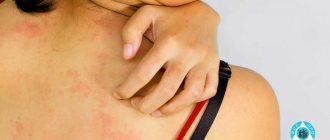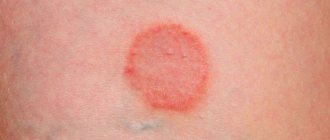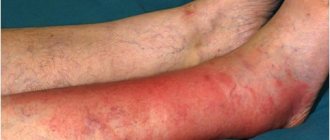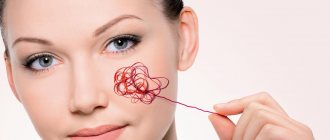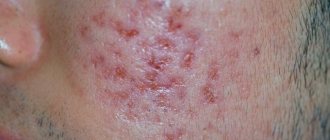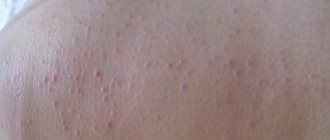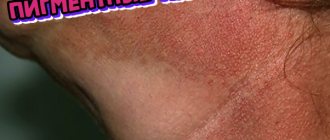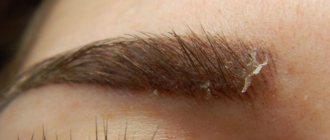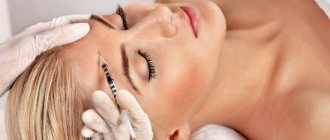The skin is the largest organ in humans. It reflects everything you eat, use in everyday life or use as care. And a person’s face is the most important and visible part of the body. Therefore, the skin of the face burns and itches, which causes a lot of inconvenience. An uncomfortable state can even provoke stress with subsequent problems. If you or your loved one's face is red, burning and itchy, you should immediately consult a doctor. Timely identification and elimination of the causes will allow you to avoid complications and solve the problem as soon as possible.
Causes of facial irritation
Human skin reflects the processes occurring in the body and reacts to any changes in it. That is why, in cases where the skin of the face is very itchy, experts recommend not to delay and consult a specialized doctor. After conducting the necessary research, he will accurately determine the cause that provoked irritation, redness and itching of the skin. Only after this will it be possible to take adequate measures to eliminate these unpleasant signs.
In the case when treatment of a scourge is started without clarifying the prerequisites for it, a person may develop serious complications that cause significant damage not only to appearance, but also to general health. Most often, experts diagnose the following consequences of inadequate therapy that eliminates redness of the facial skin, or its complete absence, such as:
- the appearance of flaky crusts;
- significant swelling of the entire surface of the face or certain areas of it;
- formation of purulent ulcers at the site of scratching.
Itching of the facial skin, provoked by the use of inappropriate therapy, can be prevented not only by timely contacting a specialist and finding out the true cause of such an aesthetic scourge, but also by strictly following all the doctor’s recommendations and prescriptions during treatment.
There are several prerequisites, as well as risk factors, that cause itching and redness on the face. All of them should be considered separately in order to have a general understanding of them.
Allergic reaction
Allergens can be caused by a variety of factors. At the same time, each person may have something specific that is an irritating component. The most common causes of allergies are:
- Food;
- medical supplies;
- household chemicals;
- pollen of flowering plants;
- dust, wool, dirt.
Allergic rash on face
Note! The allergy is accompanied by a small rash and redness of certain areas of the skin. The affected areas burn and itch, and swelling may occur. It is necessary to take an antihistamine as soon as possible and make an appointment with a dermatologist. Try to remove possible sources of the disease. Most likely, you will need to take tests to identify the allergen.
Allergy as a cause of itching
As already mentioned, our skin reacts to everything without exception - air, food, emotional background, health status, infectious lesions, and so on. The condition of the epidermis is directly related to these endogenous and exogenous factors. The more deviations from the norm there are, the worse our skin looks.
The first to suffer are the facial and hair parts of the scalp, which begin to itch and burn unbearably. In response to a frequent question from patients about what types of allergies can cause itching on the face, experts note the following types of allergenic factors:
- Food. It occurs when a person consumes foods to which his body reacts very sharply. Most often, citrus fruits, strawberries, chocolate, nuts, dairy products and synthetic additives provoke burning and redness of the skin.
- Contact is associated with the use of hygiene products or cosmetics that are not suitable for the skin type, as well as local pharmaceuticals.
- Medication is the body’s reaction to vaccination or the medicinal use of certain medications intended for oral administration.
- The skin of the face can also itch due to exposure to thermal or cold factors (heat or frost with strong wind, as well as high humidity).
- A fairly large reddened area of skin can appear when a person abuses ultraviolet radiation - excessive use of a solarium or prolonged exposure to direct sunlight.
The fact that the face is red, burning and itchy due to some allergic reaction is indicated by both external signs that appear on the skin and the subjective sensations of the person affected by the misfortune. Usually this is a stuffy nose, redness of the skin (it turns red all over or in certain areas), severe tearing, the appearance of numerous pimples, wounds, blisters or a pronounced rash on the face.
But it is not at all necessary to confirm that the itching effect on a person’s face was influenced by an allergic reaction, to have all of the above signs. Often this type of attack manifests itself with two, and sometimes three pathological symptoms. If children suffer from an allergic type of illness accompanied by itching of the face, they will always have bright red rashes in the form of hives, which are mostly absent in adults.
Skin diseases
Any problems associated with skin diseases require mandatory treatment under the supervision of a doctor. Most often, the face burns and itches due to one of the following diseases:
- demodicosis – subcutaneous parasitic mite;
- dermatitis - can be contact, atopic or allergic;
- psoriasis;
- seborrhea;
- Rosacea.
Demodectic mange on the face
Important! Each skin disease has a different etiology. The methods and means of their treatment also differ. Therefore, if the skin turns red and burns, or some spots appear that itch, then you should immediately consult a doctor.
Risk factors for the development of the disease
If your face itches, the reasons may not only be allergic reactions. The appearance of itching and flaking is greatly influenced by dry skin, which can be either acquired or congenital. It is this that is the main risk factor that contributes to the appearance of negative manifestations on the skin of the face. Its direct participation in the appearance of itching is due to the fact that dry skin always cracks, as a result of which microscopic defects form on it. Through these cracks, the infection actively penetrates into the deep layers of the epidermis, causing a severe itching effect in a person.
Also, when asked by their patients why their face itches, experts point to the following risk factors that provoke this pathology:
- problems with the nervous system, which are provoked by frequent stress, increased mental and emotional stress and anxiety;
- diseases of the internal organs also provoke the development of itching on the face, accompanied by redness of the skin;
- An important risk factor is the presence of bad habits, alcoholism and smoking.
Those who neglect the rules of a healthy diet also run the risk of suffering from redness and itching of the facial skin. Nutritional disorders that always provoke the appearance of this cosmetic scourge on a person’s face are considered to be the consumption of large quantities of fatty and sweet foods, as well as the constant presence of pickles, marinades and smoked foods in the diet.
In order to prevent the development of a pathological condition, you should fully analyze your lifestyle. This will help you understand what causes have a greater influence on the appearance of this aesthetic ailment, and completely eliminate them from your life. When identifying a predisposing factor, experts recommend taking into account the fact that there are usually several of them. That is why it is best to consult a specialist to diagnose the problem, since it is quite easy to lose sight of any of the reasons on your own, and therefore the treatment of the pathology will be incomplete.
Dry skin and weather factors
If you notice that after prolonged exposure to the sun your red face itches and burns, then most likely the allergy is caused by ultraviolet rays. Spots may appear on the face and neck. Such irritation requires the mandatory use of cosmetics with increased protection against UV rays. And also, to prevent the face from being red and the itching to go away quickly, it is necessary to use moisturizing creams.
Dry skin on the face
The skin can itch and burn due to exposure to wind and cold. Especially in winter, when there is severe frost, exposed areas of the body suffer greatly. It is better to treat the ears, nose and cheeks with a protective nutrient in advance. Lubricate your lips with balm. For some reason, many people remember this need after their face turns red.
Excessive dry skin can be caused by inappropriate skin care products. Aggressive components of cosmetics cause irritation. If you notice that after treatment your face burns and itches, then you should immediately replace your care products with more gentle and nourishing ones. Your face may be burning and itching due to an allergy to soap, tonic, or lotion. Be careful about your skin.
Troubleshooting
In order to completely get rid of the aesthetic scourge that occasionally appears on the face, the cause that provokes it must be eliminated. Only after this the therapy can give a positive result. All therapeutic measures that relieve a person from misfortune must be prescribed by a specialist and carried out under his direct supervision. This is necessary because during therapeutic treatment of the face with medications, it may be necessary to adjust the treatment course used. To prevent misfortune, you must follow the following rules:
- daily moisturizing and nourishing of sensitive skin is carried out with high-quality hypoallergenic creams;
- It is recommended to replace all alcohol-containing preparations with cosmetic milk or emulsion;
- For morning washing, it is best to use herbal infusions.
The diet should be sufficiently enriched with fresh herbs, vegetables, fruits and berries.
Also, in no case should you allow scratching of the itchy skin, otherwise this will provoke the entry of pathogenic microorganisms into the resulting wounds and the subsequent development of pathological diseases of the face, which will significantly aggravate the situation.
Treatment
Treatment of flaky skin must be carried out taking into account the cause of damage to the dermis. In each case, the therapy regimen is selected individually. Treatment is prescribed by a trichologist or dermatologist.
When skin flakes appear on the scalp for washing, you must abandon traditional shampoos and conditioners. You should also make adjustments to your daily diet.
The patient must avoid fried, salty, fatty foods and alcohol. In your daily diet you need to reduce the content of sweets and flour.
Instead, it is recommended to consume more fresh fruits and vegetables.
Cosmetical tools
In the treatment of seborrheic dermatitis, hair care products are used, which include:
- zinc;
- selenium;
- sulfur;
- tar;
- resin.
These active components stop the development and spread of fungal microflora.
Advice. Among the most effective remedies used for seborrheic dermatitis is Sulsena, which is available in the form of oil, shampoo and paste. More often, pathology is treated using the latter. Sulsen paste should be applied to problem areas of the skin twice a week.
Antifungal shampoos help in the fight against pathogenic microflora:
- Sebozol;
- Nizoral;
- Mikozoral and others.
Antifungal shampoos destroy pathogenic microflora, simultaneously eliminating itching. Such products should be used no more than three times a week.
Medicines
Regardless of the specific factor that caused flaking of the scalp, salicylic oil is used to remove scales. The product softens the tissue, making the crusts easily removed.
In advanced cases in adult men and women, seborrhea is treated with local medications, which include corticosteroids or hydrocortisone with cliosinol.
Psoriasis requires complex treatment. In the treatment of the disease, antihistamines are actively used to help cope with itching:
- Tavegil;
- Suprastin;
- Erius;
- Telfast.
For the generalized form of psoriasis, the treatment regimen includes preparations of gluconate and calcium chloride. Pathology therapy is also supplemented with immunosuppressants: Azathioprine, Cyclosporine. For local treatment of the skin for psoriasis, ointments based on glucocorticosteroids are used.
Important! In case of suppuration of the skin, the head must be treated with antibacterial ointments.
Traditional methods
You can use unrefined olive oil to remove skin flakes. The product also helps relieve itching. 5 tbsp. l. olive oil must be heated to 50 degrees in a water bath and mixed with 1 tbsp. l. lemon juice.
The resulting composition must be applied to the skin and left for 20 minutes. Then the mask is washed off with non-allergenic shampoo. It is recommended to repeat this procedure twice a week.
If the skin is very dry and flaky, use an onion mask. It also strengthens the hair. To prepare the product, just pass one onion through a meat grinder. The resulting paste should then be applied to problem areas of the skin and left for 40 minutes. The mask is washed off with warm water.
To restore the condition of the skin, you can rub a decoction of coltsfoot into your head every day before bed. To prepare the product, gently pour a glass of boiling water over a tablespoon of the plant and leave for an hour.
Parasites
Small and invisible parasites can provoke skin inflammation due to microtraumas. This infection is called demodicosis - these mites travel along the sebaceous canals, damaging them. Treatment is carried out for a long time so that not a single individual remains.
Remove unpleasant symptoms with the help of ointments and gels. The use of camphor alcohol is negative for parasites. It immediately relieves the itching disorder after rubbing the affected area. To destroy the tick, you can resort to therapy using medical devices.
Why does your neck itch, symptoms:
- Skin rash in the form of rash, red spots, redness.
- Swelling at the sites of the rash.
- The skin becomes painful, becomes crusty, and peels off.
- Sometimes there is a headache and cough.
- Chills and fever.
- There is a sore throat and runny nose.
Causes of red spots depending on location
The location of irritation and spots on the face and their condition will tell the doctor what caused the skin damage.
Irritation under the eyes and upper cheeks
Reddened cheeks and the area under the eyes indicate increased blood pressure.
Redness on the tip of the nose
Red spot on the tip of the nose - you should consult a cardiologist.
Irritation and redness in the perioral area
If there is redness or irritation in the mouth area, it is necessary to check the liver and gallbladder function.
Red spots on the forehead, cheeks and nose
Red and pink spots spread over the entire cheek area, forehead, nose, and chin. This is typical for rosacea (rosacea).
